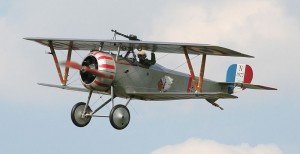OK, have you seen the movie, Flyboys? If not, why not? You call yourself an aviation aficionado, right? Well then, you have to see this movie.
The amazing thing about the movie is not the story, but story of these specially built airplanes, which were to be the stars of the movie. The airplanes Hollywood needed were full-scale Nieuport 17s and of course, there were none around. Nieuport 17s just do not exist today, the way they may have a hundred years or so ago.
There was little question someone would have to build the airplanes from scratch; other questions abounded… Could anyone do it? Was there enough time? Who could do it? Was there an appropriate place?
The appropriate place and the person who could turn out the airplanes was Robert Baslee of Airdrome Aeroplanes of Holden, MO. After discussing the project with the producers, Baslee agreed to construct two airplanes in 60 days. That’s two airplanes, from scratch, and flying—in 60 days.
To ordinary homebuilders and airplane mechanics and pilots, this might seem an impossible task. From scratch to flying—in 60 days? Agreeing to such could be a recipe for disaster.
But Baslee and his team of builders got on it. After negotiations and sealing the deal, ten days into the project, Hollywood calls back as says, “Holden, we have a problem.”
They needed an additional two airplanes. Baslee, started thinking up how to accomplish the goal, and told them he would need a little extra time. In typical Hollywood fashion, they said, “No, we are limited by our original time schedule.” So now, 10 days into the project, Baslee and his company have to play catch up to supply a total of four Nieuport 17 replicas. He agrees; he thinks he and his team can do it.
Fifty-two days later, the airplanes are complete and flying.
Now, the movie, if you are a pilot and have even a remote interest in World War I aviation, is a very good movie. (Hollywood never makes great aviation movies, but this one is good.)
The fiction of the movie, based around the story of the Lafayette Escadrille, is about a squadron of American flyers who volunteered to fly for France in World War I. The plane above shows the squadron insignia painted on the sides of the aircraft assigned to the Escadrille Américaine 124.
Escadrille 124 consisted of five French officers and the first 38 American pilots. The Americans, also known as the Valiant 38, would later lose 10 of their own in combat throughout the war against the Germans.
The squadron’s first major combat was at Verdun on May 13, 1916. Later, the Germans would protest the use of pilots from a neutral nation fighting in the war. This led to the military changing the name of the squadron from Escadrille Américain 124 to Escadrille 124.
After America entered the war, command of the Escadrille 124 was transferred to the US Army Air Corps and it was designated the 103rd Aero Squadron. The Valiant 38 and the many men who would follow and serve as volunteer pilots for the French proved themselves well.
Most have been gone for a long time now, gone west. There remain no more veterans from the War to End All Wars.
With the passing of Frank Buckles earlier this year, the last American veteran from this war has passed.
-30-
© 2011 J. Clark


Yes. the best thing since Dawn Patrol. I suppose the flying scenes were done digitally but I felt the planes moved too quickly and acrobatically than the real machines. Is this assessment correct? I was sure hoping he would find her.
Yes, Carl, I think your assessment is right on. When Hollywood starts doing things digitally, sometimes they lose track of how fast or slow time actually goes. Some of the scenes were well timed, some were actually slow, and as you have pointed out, some of the flying was a little on the fast side.